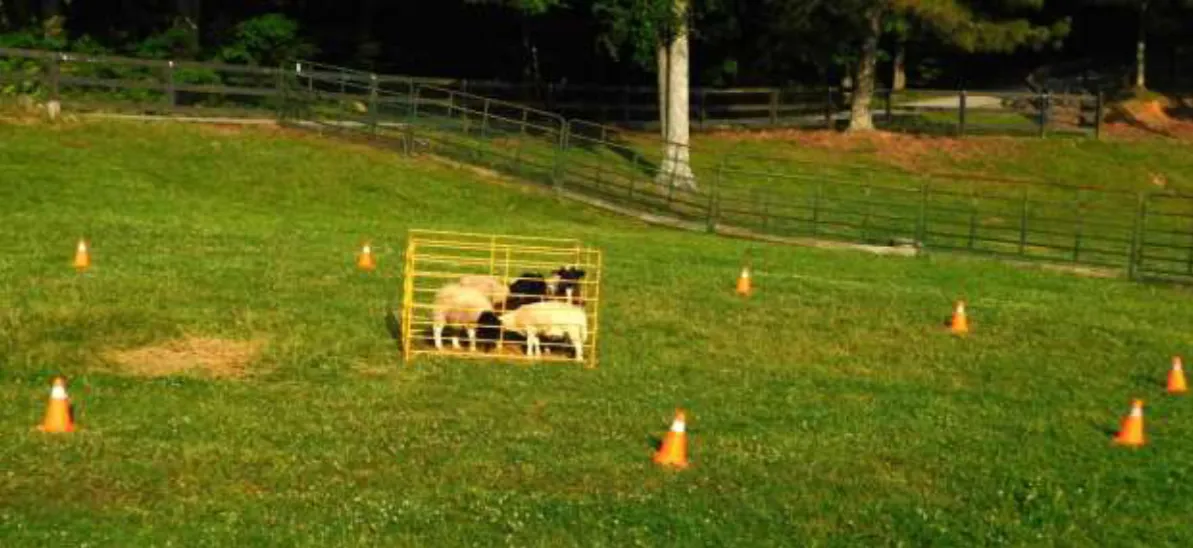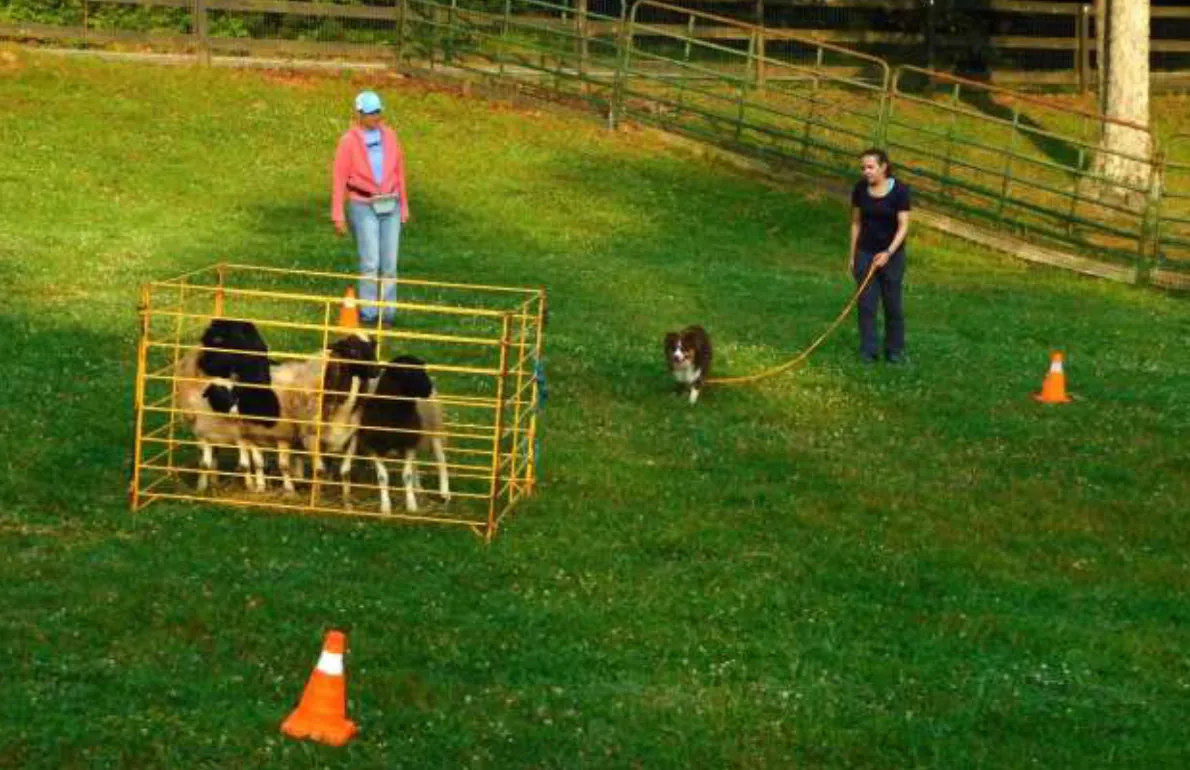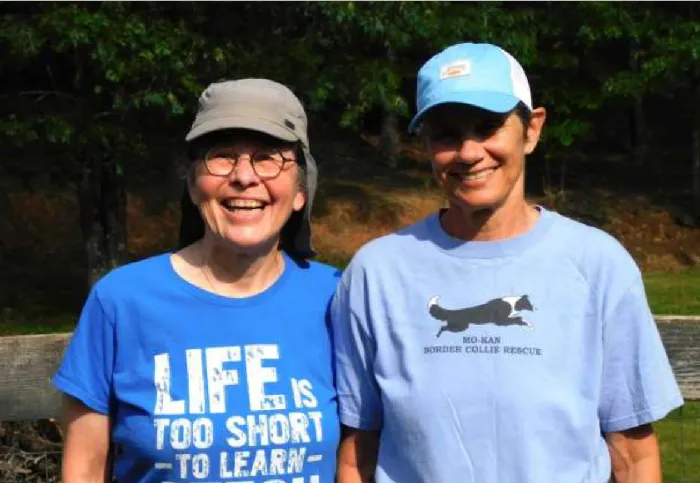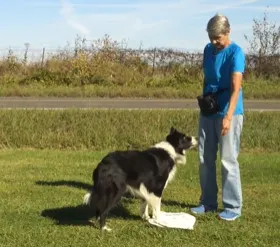PHD Blog 94 - Positive Herding Workshop - Georgia 2023
Wonder what the seminar was like?
This is your chance to find out.
The workshop is long gone, but great memories live on.
If you have wondered what a positive herding workshop is like, then I invite you to see it through the eyes of one of the participants. Laurie Lo attended my workshop with her Beardie named Bissii.
Several different breeds were represented at the workshop, including the expected border collies, Aussies, Mini Australian Shepherds, and Beardies. We also had a couple breeds that are more rare at herding clinics including a Goldendoodle and short, squat delightful crossbred named Ophelia.
Here is Laurie's article:
Confessions of an Obedience Junkie
Barb Buchmayer’s Positive Herding Seminar
With five or so sheep in a free-standing pen, the clinician instructed the handlers to engage with their dogs. The teams maintained a 12 ft. distance from the sheep and a good distance away from each other. If a team couldn't engage because of the ovine distraction, it moved further away from the pen until the dog and handler could interact with each other (treating with food, playing tug, doing basic obedience maneuvers).
Some dogs had a terrible time ignoring the sheep. One little slick-coated border collie became catatonic when she saw sheep. Her handler had to move her a considerable distance away from the pen to get her to "think" about anything other than the sheep. Nobody asked the sheep what they thought about the activity. But I suspect that two of the ewes retreated to their bunks after the seminar and enjoyed two pints of cold beer.
The idea of teaching a dog to engage with its trainer in the face of mind-bending sheep is a fundamental "herding" skill. It develops a dog that can respond to a handler's commands when working the flock. We obedience junkies teach the exact same skill to our competition obedience dogs.
I had never attended a herding seminar in which the clinician discussed “proofing” the dog around stock before allowing it to engage the sheep. Not only does this benefit the dog and handler, but it benefits the sheep. They don't have to worry (as much) about a Cujo entering their field and terrorizing them. (Sheep, as prey animals, are always worrying about Cujos).

Photo 1- The sheep distraction.
The clinician, Barb Buchmayer, has developed a new way of teaching herding and is spreading the word! It all began 15 years ago, when Barb decided that there had to be a more dog friendly way to train herding. She felt that clicker training held the key to this approach, and she even attended Bob Bailey’s FAMOUS Chicken Camp.
While Barb was working on developing an operant conditioning approach to teaching herding fundamentals, Sally Adam, a clicker trainer in South Africa, contacted Barb about teaching her how to herd using positive reinforcement. Barb, a 30 plus year Open herding competition veteran, and Sally, a complete novice, began their partnership. Barb communicated her learning strategies to Sally via the internet and Skype. Sally beta tested these strategies with her border collie Renn. In 2016, Renn became the South African Sheepdog Association’s National Reserve Junior Champion.
Day One
While some of the workshop attendees had some herding experiences, many were complete novices. No one had ever experienced Barb’s approach to herding. All of us were ready to learn and to have fun.
We learned that herding is a team effort! The dog doesn’t have any idea where to move the stock unless it does the same chore day after day. It is up to the handler to come up with a (stock movement) game plan and relay it to the dog. The handler relays the game plan via commands and adjusts the calls depending on how the livestock reacts to the dog.
A dog with a lot of instinct will learn how to read the stock and adjust as he executes the commands. A talented dog with a lot of instinct is like Kansas City Chief quarterback Patrick Mahomes who scrambles to make a touchdown when the offensive front line unexpectedly collapses. A dog with little or no instinct will rely upon the handler to read the stock and make those adjustments for him via additional commands. All dogs on the talent spectrum must learn basic herding skills and their associated commands.
We got to try our hand at teaching our dogs several herding commands: the directions, a stop/down, and a walk up. Some folks used pure operant conditioning, others used luring. We all used food. I learned that the quicker I treated my dog to mark a particular nano-behavior, the quicker my dog learned the behavior. As a leash and collar trainer, I was not quick on the draw with food. I learned. I became a Pez dispenser in a five-year old’s hand. My eyes were not attuned to noticing nano-behaviors. I learned. I became an eagle.
Barb warned us not to try to do too much when shaping a behavior. Baby steps. Quick rewards. I had to adjust the criteria (up the ante) for a specific behavior on the fly when I felt my dog was ready to move on. That was tough! If my dog became confused, I had to lower the criteria on the fly and then build the criteria back up. The learning dynamic was very different from the pressure-release modality that I normally use. But it was fun! My dog was a locomotive moving slowly at the start, gathering speed as he began to understand the process and running down the track once he figured things out.
Day Two
While we spent the first day indoors in a climate-controlled agility building, the next day we gathered at a sheep farm. It was cool and cloudy. Just perfect for learning about moving livestock. After the handler/dog teams worked engagement near the penned sheep (described at the beginning of this article), Barb introduced us to sheep and dog reading.
The twelve teams spaced themselves equidistant on an imaginary 30 ft. diameter circle with the penned sheep in the middle. Each team took turns walking directly toward the sheep. The handler was to stop when the sheep noticed the dog. Most of the folks were unfamiliar with sheep, but I, the sheep farmer, could see the concern in their eyes as each team approached. A sheep ear would flick, stomp a leg, the group would bunch up and move.
Many handlers did not notice the effect their dogs were having on the sheep until the sheep moved. It took a few tries for some handlers to identify the start of the silent communication between their dogs and the sheep. While I have attended many herding seminars, this is the first time I have witnessed teams being instructed on this core subject. It is critically important for the handler to understand how sheep perceive the dog. Based upon this information, the
handler can design a safe and sedate travel plan for the herd.

Photo 2- Learning to read the communication.
The newbie teams were sweating communication bullets during the reading exercise. Some couldn’t look at the sheep because they were transfixed by their dogs. But they learned how to read both at the same time! Afterward, we relaxed and watched a herding demonstration. Everyone was amazed as a seasoned team took the sheep out of the free-standing pen, walked them around a bit, and then tucked them back into the pen.
Barb outdid herself coming up with the last “A Ha!” exercise. The seminar participants formed six teams, one team member being the handler, the other the dog. Using the commands learned the previous day, the “handler” was to verbally direct the dog to move real live SHEEP! on a “course” known only to the handler. While this may seem easy, most of the folks had never been around sheep.
Additionally, the herding directional commands are not self-explanatory. “Go Bye” means circle clockwise. “Away” means circle counterclockwise. The other recently learned commands: ”walk up” directly toward the stock, “back” directly away
from the stock, “slow,” “fast,” “stop” and “out” (move laterally away from the stock).
The teams were excited and fearful. Nobody wanted to look foolish. But we were all game to give this exercise a shot. I had an enthusiastic but not-so-talented dog.
When Barb told me that my dog was to drive the sheep between the fence and a tree, I had an anxiety attack. The space was narrower than the group of sheep. They’d all have to shoot the gap single-file. As my not-so-talented dog got too close to the sheep, they began to panic. I kept telling my dog “back.” She did NOT respond. Finally, I addressed her in English. “Get back. You are putting too much pressure on the sheep.” She backed away and the sheep calmed down and walked between the fence and the tree, one after the other. We were victorious! “That’ll do.”
I left the seminar with a new way to train my dog to herd: train the basic commands away from sheep. Why “fight” for my dog’s attention by teaching him these commands around sheep? Once my dog understands the commands, I can “proof” those commands around my sheep. We will have a head start to interact and move stock without drama or trauma. There will be times when my dog may become confused and forget what he’s learned. When that happens, I can help him review the “forgotten” commands. That’s so much better than my watching my overwhelmed and unthinking dog chase sheep all over the field while I scream and become hoarse.
This approach is cost effective and less overwhelming for those who have to “rent” sheep. Sheep are pricey. Maybe not per head, but travelling to the sheep farm, paying for instruction, renting the sheep, and then settling up for the one your dog just killed adds up to a significant chunk of change. Why spend the time training basic commands around sheep when it is so much easier to do it at home? Cheaper too! Proof the commands at the sheep farm, but don’t waste money teaching those commands at the farm, under duress.
Without a doubt, the sheep come out on top with this approach to herding dog training. While a newbie dog may have a tough time being calm around livestock, he also can find comfort in following his handler’s commands. The sheep will thank the dog for that. Herding should not be a rodeo. It should be an activity in which the sheep are calmly moved from one place to another by the dog/handler team.
For those of you who might want to give Barb Buchmayer’s Positive Herding a whirl, here are some resources.
https://youtu.be/6sto7v6vFjl Positive Herding Dog Into with Barb Buchmayer #1
www.youtube.com/channel/UCTFPE9f8Niu5I2c4uVH6IAw Positive Herding Dog - YouTube
Positive Herding 101 Dog-friendly training, Book 1 of 2 by Barbara Buchmayer with Sally Adam
Positive Herding 201 Advanced dog training, Book 2 of 2 by Barbara Buchmayer

Photo 3- Author Laurie Lo with clinician Barb Buchmayer (right).
That's it! A sneak peek into a positive herding workshop. My next herding workshop will be in September in Upstate NY. I will also be doing an Enrichment Games workshop that weekend. Come join the fun and learning!
For more info on my upcoming workshops, drop me a note at [email protected]
Please join me on Facebook at Positive Herding Dog and Enrichment Games for High-Energy Dogs.
If you found this blog helpful, please tell your friends and
spread the herd!
Barb
Join my list to receive the latest news and updates.
(Don't worry, your information will not be shared.)

